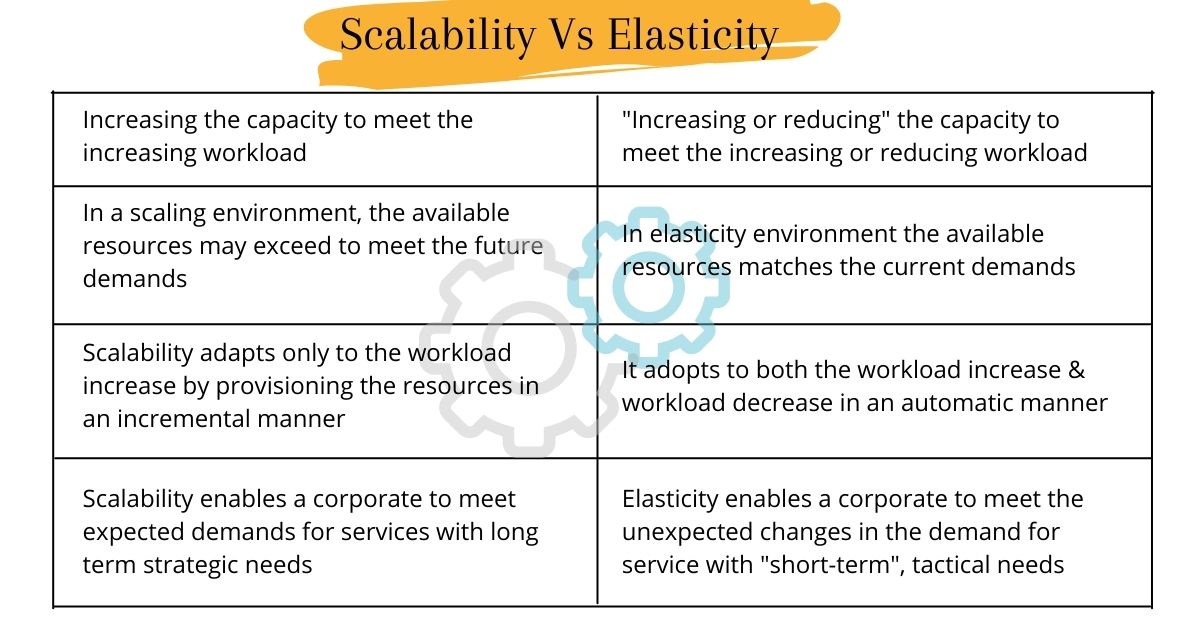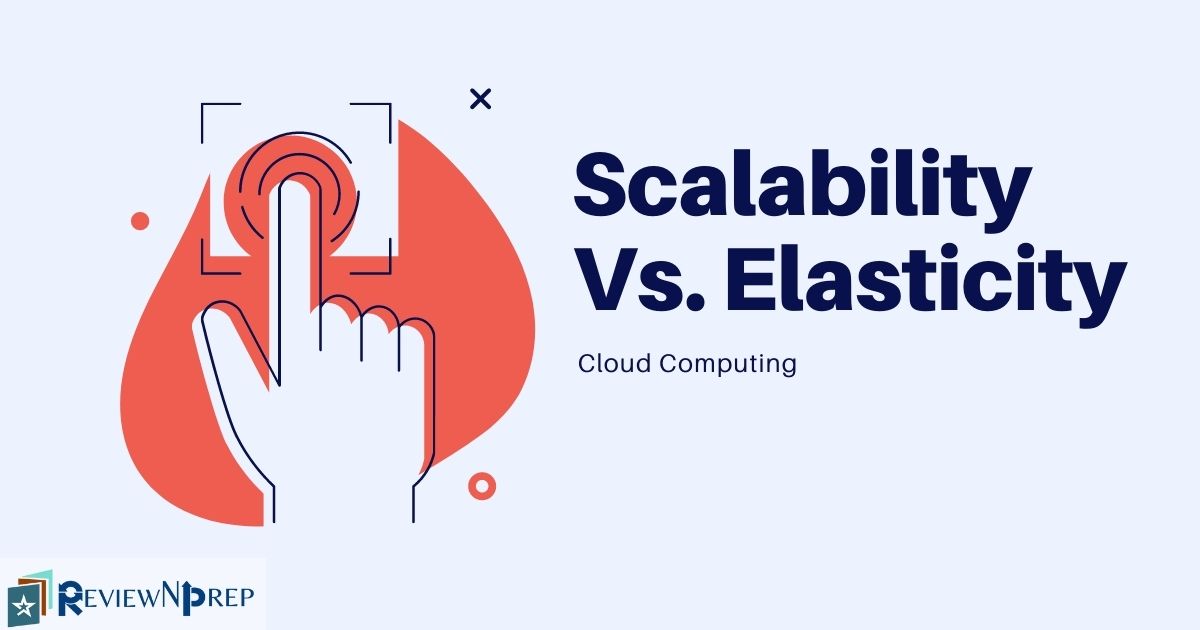|
|
It’s been ten years after NIST clarified the difference between Elasticity vs. Scalability. But cloud elasticity and cloud scalability are still considered equal. For this reason, both terms seem to be used interchangeably. But the definition of scalability and elasticity in cloud computing is not complete without understanding the clear connection between both these terms.
Both of these terms are essential aspects of cloud computing systems, but the functionality of both the words are not the same. They are quite different as they seem.
If you are new to cloud concepts, check this out :
What is Scalability in cloud computing?
Scalability handles changing needs of an organization within the defined constraints (hardware, software, etc.), without it negatively affecting performance. Example: increasing loads on a system.
In other terms: it is the ability of a system to remain responsive as user load gradually increases over time. A scalable solution enables stable, longer-term growth in a pre-planned manner.
With cloud scalability, businesses can avoid the upfront costs of purchasing expensive equipment that could become outdated in a few years. Through cloud providers, they pay for only what they use and minimize waste. The cost savings can really add up for large enterprises running huge loads on servers.
What is Elasticity in cloud computing?
Elasticity – generally refers to increasing or decreasing cloud resources. An elastic system automatically adapts to match resources with demand as closely as possible, in real time. Example – adding more number of virtual machines.
In other words, it is the ability of a system to remain responsive during significantly high instantaneous spikes in user load. If the system is not adaptable but is scalable, it does not comply with the definition of Cloud.
How to achieve cloud scalability?
There are two basic types of scalability in cloud computing: vertical and horizontal scaling.
To scale vertically (scaling up or scaling down), you add or subtract power to an existing virtual server by upgrading memory (RAM), storage or processing power (CPU). This means that the scaling has an upper limit based on the capacity of the server or machine being scaled; scaling beyond that often requires downtime.
Scale-up: Increasing/adding power to an existing resource
Scale down: Decreasing/taking out power from an existing resource.
To scale horizontally (scaling in or out), you add more resources like servers to your system to spread out the workload across machines, which in turn increases performance and storage capacity. Horizontal scaling is especially important for businesses with high availability services requiring minimal downtime.
Scale in: Remove resources from an existing resource group/set.
Scale out: Add resources to an existing resource group/set.
Elasticity and scalability may be offered together as a service by a cloud provider, but they provide different functionality from one another. Each company has its own unique set of requirements; therefore, no one size fits all when it comes to choosing between these two.
Scalability vs. Elasticity

According to the definition of cloud computing, as stated by NIST in 2011, Elasticity is considered a fundamental characteristic of cloud computing. In contrast, Scalability does not.
Elasticity does not exist without Scalability.
When is Cloud Elasticity Required?
For a cloud to be a real cloud, rapid Elasticity is required instead of just Elasticity. It does not mean that your system should be 100% elastic. As long as it can be flexible, it’s always an accurate cloud system.
Common use cases where cloud elasticity works well include e-commerce and retail, SaaS, mobile, DevOps, and other environments that have ever changing demands on infrastructure services. Some of the real time examples for your system to be Elasticity ready are retail services sales like Christmas, Black Friday, Cyber Monday, or Valentine’s day.
A good use case for Cloud Elasticity that everyone would be able to relate to is streaming services like Netflix. A new movie or a season of a famous show could mean a sudden traffic surge of people logged in to watch Netflix on the weekend. This sudden spike can be handled by a surge of compute resources provisioned for a small amount of time.
It goes without saying that Automation Tools play a big part in enabling elasticity and fault tolerance. The monitoring tools can detect the higher CPU usage and automation kicks in to provision more compute resources.
Opposite to this, if your business is selling software or a small company with predefined growth throughout the year, you should not worry about elastic cloud computing. Having a predictable workload where capacity planning and performance are stable and have the ability to predict the constant workload or a growth cloud scalability may be the better cost saving choice.
The Rise of Cloud
Businesses are investing heavily in cloud computing resources, and professionals with the right set of skills are much in demand.
When adopting cloud computing, companies subscribe to a cloud service provider and pay for resources as used or on a discounted contract rate.
Amazon Web Service (AWS), Azure, and Google are dominating the market and are responsible for provisioning, managing, and maintaining infrastructure. This allows companies to focus on optimizing workloads and performing revenue-generating tasks.
Check out:
AWS-The Ultimate BEGINNERS Guide
Reasons to Take up A Cloud Computing Certification
Companies increasingly are seeing the Cloud as a digital transformation engine as well as a technology that enhances business progression.
As work from home became a part and employees were forced to go remote, tasks were largely done on cloud infrastructure.
Certifications in cloud computing can help clearly define who is qualified to support an organization’s cloud requirements.
Growing demand for cloud computing professionals
According to Statista: The worldwide public cloud computing market continues to grow and is expected to reach an estimated 397 billion U.S. dollars in 2022. This encompasses business processes, platforms, infrastructure, software, management, security, and advertising services delivered by public cloud services.
Conclusion of Cloud Elasticity in Cloud Scalability
Scalability and Elasticity both are essential characteristics of cloud computing & Now, it is clear that the ability of a system to scale down or scale up is fundamental, but it is entirely different from its capability to respond quickly. The ability to scale up is not as efficient as reacting swiftly to a downtime or service shutdown.
The ability to scale up and scale down is related to how your system responds to the changing requirements. Elastically in the context of cloud computing, it is required that the scaling of the system is quick, and it means the variable demands that the system exhibit.
There should not a need for manual action if a system is a true cloud. The response system should be completely computerized to respond to changing demands.
ReviewNPrep’s community of users helps each other with career journeys and identifies trends and latest resources through valuable discussion forums. Upskilling through professional certifications has never been in higher demand.

